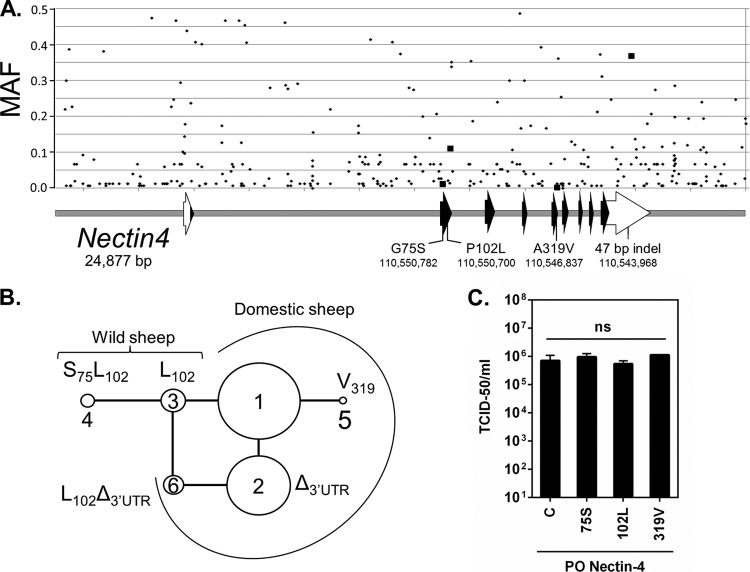Fig 3.
Genomic structure, polymorphisms, unrooted median-joining network, and effects of allelic variants of ovine Nectin-4. (A) Genomic map of Nectin-4: white arrows, 5′ and 3′ UTR of exons; black arrows, exon coding regions; gray rectangles, introns or intergenic regions; small diamonds, positions and minor allele frequencies (MAF) of SNPs in an international panel of 75 sheep; large squares, position of Nectin-4 missense polymorphisms and 47-bp indel in the 3′ UTR. The codon polymorphism sequences are as follows: G75S, GGC→AGC; P102L, CCC→CTC; A319V, GCA→GTA. The major and minor alleles for the 47-bp indel in the 3′ UTR are 5′-TAACA[AGAGGACAAGTAAGGTCCTTGGCCTTGCGGTTCCTCGGCTCTTCCCC]TAGGC-3′ and 5′-TAACA[]TAGGC-3′, respectively. (B) Unrooted median-joining network of haplotypes comprising G75S, P102L, A319V, and 47-bp 3′ UTR indel variants. The areas of circles are proportional to the frequencies in the 75 ISGC sheep (see Table S1 in the supplemental material). The predicted sequence of variable sites for the most frequent haplotype (1) was G75, P102, and A319 and contained the 47-bp insertion in the 3′ UTR. The difference from and relationship to haplotype 1 are indicated for each additional haplotype. The delta symbol indicates the deleted form of the 47-bp indel polymorphism. (C) PPRV infection of transduced PO cell lines overexpressing Nectin-4 haplotype isoforms. Abbreviations for cell lines: C, control line overexpressing the most common Nectin-4 haplotype in domestic sheep (haplotype 1: G75, P102, and A319); S75, line with S75, P102, and A319; L102, line with haplotype 3 (G75, L102, and A319); 319V, line with haplotype 5 (G75, P102, and V319). All four cell lines were infected at an MOI of 4 with PPRV (Ivory Coast 1989 strain). Virus was harvested at 48 h p.i. by freeze-thawing. Virus titration was performed on Vero cells expressing canine SLAM with a detection limit of 10 TCID50. All infections were performed in triplicate; the error bars denote standard deviations from the means. PPRV replication rates were compared using an unpaired two-tailed t test (ns, nonsignificant).

